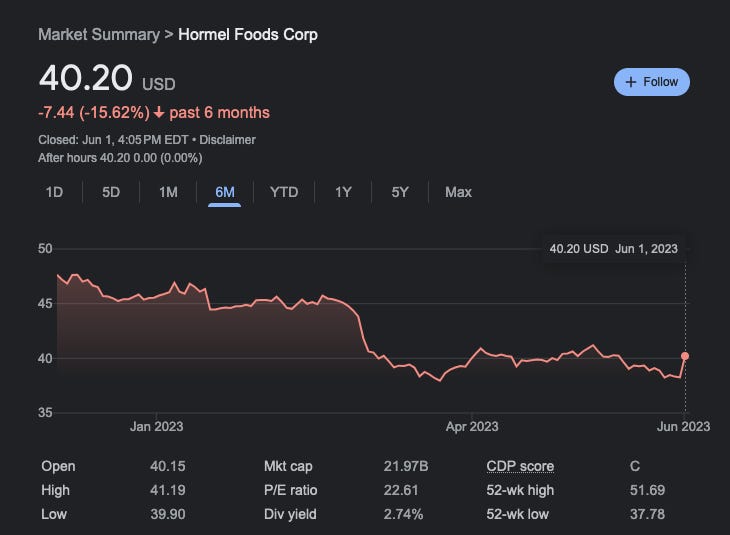Sticking the Landing, No Sully Required
Malt Liquidity 101
In January, I said that I was pretty sure that a soft landing would occur due to inflation being primarily a supply side issue:
Since then, we’ve seen inflation drop below 5%.
Let’s revisit Brainard’s inflation theory in particular:
High inflation essentially just means that too much money is chasing too few goods. There are two main competing theories on this. One is that issues with the supply side is causing inflation — rather than focusing on demand reduction, the theory goes that inelastic supply and supply shocks are causing a shortage of goods, which is leading to their bidding up. Some examples of supply shocks are supply chain issues or geopolitical activities affecting the transaction and production of a commodity such as crude oil. This is the theory propagated by Lael Brainard, the Fed’s number 2.
While this obviously differs from a Turkey situation where there is simply no point holding the currency, the toilet-papering of the economy in this fashion is indicative that something is wrong, that it’s not just rampant growth fueling inflation. When combined with rising rates, all of a sudden reliable cash-generation becomes very valuable — yield and consumer staples thrive, while growth languishes. This is nothing new, of course, but take a look at what’s going on now, since I made that tweet:
The logic that “people just aren’t buying enough shit” anymore is a bit reductive, and probably incorrect. Take a look at the valuations of these companies — grocery is a notoriously low margin business
Doing a similar analysis as we did in the paragraph above, we can see that grocer margins are around 1-3%.
so it doesn’t make sense why they’d be trading so high other than the fact that bonds are bid, new debt issues are nonexistent and far riskier, and the money might as well be in something rather than set on fire due to inflation.
As with all these thinly traded stocks, though, earnings are a liquidity moment, and capital will re-allocate:
The vast majority of money that moves in and around the market is based on the philosophy that whatever is invested in will create future cash flow rewarding current shareholders, who hold a right to their share of the output. When this money sloshes around, it creates market impact, which in turn creates trading opportunity. Note that these investors generally operate with a philosophy that they don’t want to react to day-to-day market movements. They are in it for the cash flow created over time and the movement in share price that will reflect that. So we want to focus on what will motivate them to decide that they want to demand liquidity and increase or downsize their positions.
Investing is driven by valuation — taking snapshots of a company’s performance over time and stringing them together to estimate future outlook. The question valuation asks is very simple: given an investment in a company, what do I own now, what am I expected to own in the future, and how much is it worth at present value?
Movement out of these safe, unchanging stocks indicates that capital is re-orienting towards future growth rather than future cash flow, making reliable growth prospects like META and NVDA bid as a result. Now, we have a report confirming this theory:
Hm. Seems a bit too coincidental that the inflation drop coincides with rapid decreases in supply chain pricing, eh? Here’s some further confirmation bias:
While this is all and good — things are returning to our 2% environment — there is still the fact that labor is tight. Inflation is not a simple, direct cause and effect phenomenon. I don’t expect rates to come down until early to mid 2024, because I still think Powell had a point:
The other theory revolves around labor market distortions, where, due to issues in the labor market, wage growth outpaces the proper level to maintain the inflation target. This could be due to multiple reasons, including low labor market participation, which causes current employees to be bid up by employers due to their negotiating power increasing.
Frankly, I feel like a lot of headlines about layoffs are opportunism — it’s maybe one of the most universal observations amongst employees in a large company or government institution that it seems like nobody is doing anything. Well, thanks to Elon Musk biting the bullet laying off people at Twitter so confrontationally, the door creaked open to allow other companies to downsize and slim their financial condition due to “macroeconomic conditions.” Certainly, as someone obsessed with writing about interest rates, this is correct — at the same time, there are plenty of well-run businesses outside the purview of FAANG who are eating right now, because the only real difference between a high-up job at Facebook vs O’Reilly’s Auto Parts was the fact that the stock-based compensation was so much more valuable in an up-only market. But more on SBC later. You can think of this current labor market as “free agency” for excess talent from big-name companies. All of a sudden, the middle and bottom of the table have access to high-tier talent, so there will be competition for them until everyone is signed. After that, you can expect the labor side of inflation to cool off as well, and rates will start to decline. I’m cautiously optimistic that we will avoid a recession because there is legitimate investment and progress being made — it’s not just a ZIRP SaaS hellhole as investors do become smarter about capital allocation with the re-orienting towards “actual products” with defined TAM.
Apologies for the shorter, chart-heavy post today, I wanted to get something positive out and not blend too many topics I’m working on at the moment. Also, stay tuned for some potential platform news!








